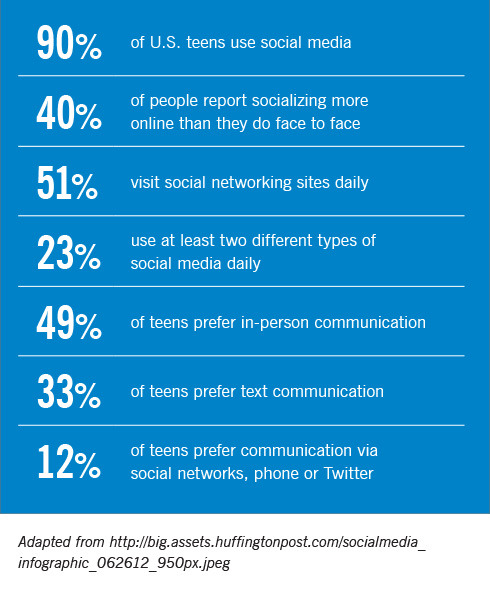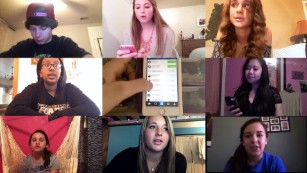What all parents need to know when their kids use social media
It can be hard to keep up with the latest apps that kids are using. Just when you’ve figured out how to talk to your kids about Facebook, they’ve moved on to Instagram or Snapchat. But here’s the deal: Even when new apps come along, adding new features such as the ability to disappear or track your location, they’re often not that different from other apps. And if you know what to look for, you can help your kid avoid some common social media pitfalls such as drama, cyberbullying, and oversharing.
Does a red flag mean your kid shouldn’t use a particular app? Not at all. Most kids use social media apps safely — and kids don’t always use every feature of every app. Also, you can often disable certain features so they’re no longer a problem. Finally, talking about using social media safely, responsibly, and respectfully is the best way to help your kid identify and avoid red flags. Here are the most common social media red flags, the apps they’re found in, and tips for dealing with them.

Age-inappropriate content
Some examples: Ask.fm, Tumblr, Vine
Friends can share explicit stuff via messaging (for example, sexting), but the bigger concern is whether an app features a lot of user-generated content that isn’t appropriate to your kid’s age. Your teen may not even need to follow users who are posting explicit stuff to come across it.
What to do: Ask your kid whom she follows, and ask to see what’s being posted. Use the app yourself and get a sense of what comes up in an average feed. Then try searching for content you’re concerned about and see how easy it is to find. Check the terms of use to see what the app allows and whether users can flag violators.
Public default settings
Some examples: Instagram, Tumblr, Twitter, Vine, Ask.fm
Many apps allow a user to have a public or private profile, only shared with friends; however, some apps are public by default, which means that a kid’s name, picture, and posts are available to everyone.
What to do: As soon as you download the app, go into the settings to check the defaults. If a kid is using the same program on a browser, check there, too.
Location tracking and sharing
Some examples: Twitter, Facebook, Snapchat, Instagram, Messenger
Wherever you go, there you are — and your social media apps know it. Though you may only indicate a city or neighborhood in a profile, allowing location identification often means that you’re tracked within a city block, and your posts may include your location.
What to do: Turn off location settings on the phone AND in the app; check to see whether previous posts include location information, and delete it.
Real-time video streaming
Some examples: YouNow, Periscope, Meerkat (Facebooksoon)
Live streaming is just that — live — so it’s very easy to share something you didn’t mean to. Kids may use these apps in private (such as in their bedrooms) and inadvertently share personal information without knowing exactly who is watching. Though they may seem temporary, embarrassing or mean moments are easily captured and shared later.
What to do: Talk to your kids about why they want to share video of themselves and what they should and shouldn’t share. Talk about positive, constructive uses of video sharing, such as creating shorts using editing programs or creating an interest-based channel to funnel your teen’s creativity.
Related: 15 Apps and Websites Kids Are Heading to After Facebook
Ads and in-app purchases
Some examples: Kik, Line, Snapchat, Facebook
Free apps have to get paid somehow, and many developers do it through advertising and providing purchase opportunities. Some track what you buy and show you targeted ads, and some even have targeted chats with businesses, which means your kid is invited into a chat with someone trying to sell a product.
What to do: Know what’s available in the app and set limits around purchases. Check out the types of ads coming at your kids, teach them to recognize all the kinds of digital marketing, and talk about what to do if they’re approached online by someone trying to sell something.
‘Temporary’ pictures and videos
Some examples: Snapchat, Burn Note, Yik Yak, Line, Meerkat, Periscope, YouNow
Nothing shared between devices is truly temporary, even when an app builds its whole marketing around it. Compromising pictures and texts get kids in real trouble because they believe what they’re sending is private and will disappear.
What to do: Let your kids know that nothing they send is truly temporary, and it’s easy for others to share what you’ve sent. Because it’s often hard for kids to really consider consequences, and they might think it won’t happen to them, it might be worth sharing some of the recent cases of kids getting in legal trouble because of “disappearing” pictures.
Subpar reporting tools
Some examples: Yik Yak, Snapchat, Omegle, Yeti – Campus Stories
Most apps have a system for reporting abuse or violations of the terms of use — but not all do. The level of moderation also varies widely. Some apps monitor posts or use automated filters to flag content.
What to do: Read the terms of service to get an idea of what’s allowed and how much posts are moderated, and have your kids read it, too. Make sure they know how to report harassment and block other users when necessary.
Anonymity
Some examples: Yik Yak, Whisper, Ask.fm, Omegle
Anonymity doesn’t always breed cruelty, but it often does. On anonymous sites, people feel that their comments are consequence-free — and end up hurting others. Also, though kids may feel safe enough to share sensitive or painful things they might not otherwise, they often don’t get the necessary support or help — and may get attacked.
What to do: Make sure your teen understands the risks involved and that they know how to block and report other users if necessary. Also, if they need connection but it’s hard to talk about a problem (especially with you), give them opportunities to share with other safe, trusted people.
Cyberbullying
Some examples: Yik Yak, Ask.fm, Burnbook (only website right now)
Though many apps have improved their monitoring and reporting features, cyberbullying is still a reality. It can happen on any social media app, but some have a notorious mean streak. If an app allows anonymous posting and is used in schools, chances are some teens will abuse it.
What to do: Ask around and pay attention to what parents, teachers, and other kids say about it to get a sense if it’s stirring up trouble. Make sure your teen understands how to report and block other users, and check the school’s policy about cyberbullying.






Leave a Reply
Want to join the discussion?Feel free to contribute!